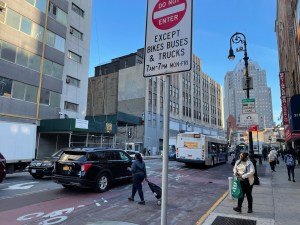Two-Way Busway Proposed For Brooklyn’s Placard-Ridden Livingston St.

Downtown Brooklyn is for bus lovers.
The placard- and double-parking-plagued bus lanes on Livingston Street will be transformed into a two-way separated busway along the street’s southern curb, the Department of Transportation revealed late last week.
DOT’s latest bus priority project would convert Livingston between Hoyt Street and Flatbush Avenue from two-way to one-way westbound for cars alongside the new two-way busway, adding new pedestrian islands, curb extensions, and other improvements throughout the stretch east of Smith Street, which serves 50,000 bus riders daily.

The proposed busway ends just west of Hoyt Street, where the street would transition to two-way traffic for all vehicles, according to DOT’s plan, which officials presented on Thursday to the project’s Community Advisory Board. Westbound buses would need to cross from over from the south curb into a westbound bus lane on the north side (green circle below). Eastbound car traffic will have to turn left Gallatin Place off of Livingston Street.

To provide a direct route to Flatbush Avenue for eastbound drivers, DOT also wants to reverse the direction of traffic on Schermerhorn Street from westbound to eastbound between Boerum Place and Smith Street. Construction at an MTA-owned building on Livingston means that the city can’t make any other bus improvements west of Smith Street, officials said.
Livingston Street is a busy commercial corridor, with most businesses along the street getting many deliveries per day, according to DOT. Officials have previously admitted that the corridor’s existing bus lanes don’t do much good thanks to near-constant blockage by illegally parked cars including many with municipal parking placards or other signifiers to help discourage NYPD from issuing them a ticket.
The traffic means subpar service on a route where the MTA runs 33 eastbound and 32 westbound buses per hour during rush hour. Buses on Livingston travel just five miles per hour, according to city data.
Residents hope the new setup will keep placard perps out of the way of bus riders.
“This is an essential transit corridor and it’s being treated like a municipal parking lot,” said Thomas Huzij, a member of Brooklyn Community Board 2, which serves the area.
“The illegal parking on Livingston would require a profoundly disturbing act of brazenness within the parameters of the new design. Targeted and automated enforcement will be necessary to complement the design but should be capable of addressing those who choose to push the bounds of decency. The Adams administration has an opportunity to set a new normal with the Livingston busway: in this city transit riders come first.”
The city will is also proposing a number of loading zones on the north side of Livingston Street, which should also be a boon to businesses on the strip — 80 percent of the street’s businesses get box truck deliveries get them between 9 a.m. and 11 a.m., when car traffic is most intense, according to DOT.
The Livingston busway is the second bus priority project in Downtown Brooklyn, after the Jay Street busway was implemented in 2021.
But the Jay Street busway is often theoretical — with transit service frequently slowed by people illegally driving on the street and parking in bus stops. That could change soon thanks to recently-passed state legislation expanding the agency’s ability to use cameras to ding people who park in bus stops and no standing zones.
The agency will present the idea to Community Board 2 this month and install the bus treatments sometime this summer. It can’t come soon enough, advocates said.
“Moving the bus lanes off the curb is a big step forward for bus riders because it’s much harder for drivers, even corrupt ones, to just abandon their vehicles and block the middle of the street,” said Riders Alliance Policy and Communications Director Danny Pearlstein.
“DOT should pay close attention to how well the varying treatments work and be prepared to go full-on busway for the corridor if the intermediate measures don’t speed up service significantly. If there’s anywhere in the city where the state’s newly expanded bus camera legislation should be transformative, it’s downtown Brooklyn, where local, state, and federal employee placard abusers have converged and dominated scarce public space for decades.”
*Correction: The article initially stated trucks would be allowed in the busway, but according to the DOT trucks will not be allowed on to drive in it due to space constraints.





